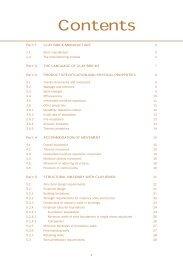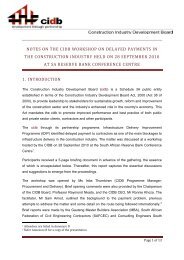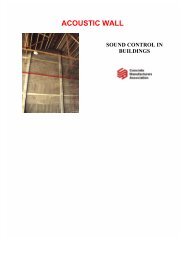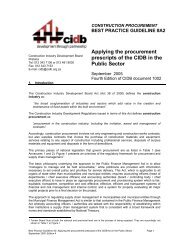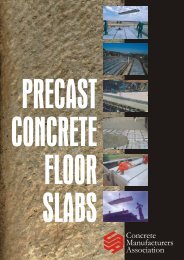MANUAL 4 - Construction Industry Development Board
MANUAL 4 - Construction Industry Development Board
MANUAL 4 - Construction Industry Development Board
Create successful ePaper yourself
Turn your PDF publications into a flip-book with our unique Google optimized e-Paper software.
MODULE<br />
1<br />
2<br />
3<br />
4<br />
5<br />
6<br />
7<br />
<strong>MANUAL</strong> 4 – BITUMINOUS PAVEMENT SEALS<br />
5.4 Finishing<br />
The surface should be rolled with one or two passes (½ wheel overlap) with a pedestrian<br />
roller.<br />
6. Notes to designers/consultants<br />
6.1 General description<br />
The Cape seal consists of either a 13,2 mm or 19 mm single seal, with an application of slurry<br />
seal. This seal is user-friendly and is a very strong/robust seal, suitable for heavy or light<br />
traffic.<br />
6.2 Application of aggregate<br />
When applying the 13 or 19 mm aggregate to the tack coat for the Cape seal, the aggregate<br />
must not be shoulder to shoulder, but must be opened up by one third to one quarter of the<br />
nominal size of the aggregate being used, as indicated in Figure 4.14.<br />
Figure 4.14<br />
6.3 Using pan and cylinder to determine ALD and application rate<br />
6.3.1 Determination of ALD of aggregate<br />
A single layer of stone is placed shoulder to shoulder, in a measured area (pan), and the<br />
volume of the stone is found by pouring the stone into a cylinder of known dimensions.<br />
The ALD can be read off the gauge in the cylinder in mm.<br />
6.3.2 Determination of application rate of stone for Cape seal<br />
A single layer of stone is placed as shown in Figure 4.14, with a gap between of 10% – 15%<br />
of the aggregate size in the pan. The volume of the stone is found by pouring the stone into<br />
the cylinder and taking the reading on the gauge.<br />
If the reading on the gauge in mm is divided by 1 000, it will give the volume in m³/m² for<br />
rate of application of the aggregate for the Cape seal.<br />
• By using the pan and cylinder method for determining the ALD of the stone, the<br />
spacing/application of the stone can be demonstrated to the labour units placing the<br />
aggregate.<br />
IMPLEMENTING EMPLOYMENT INTENSIVE ROAD WORKS 66





